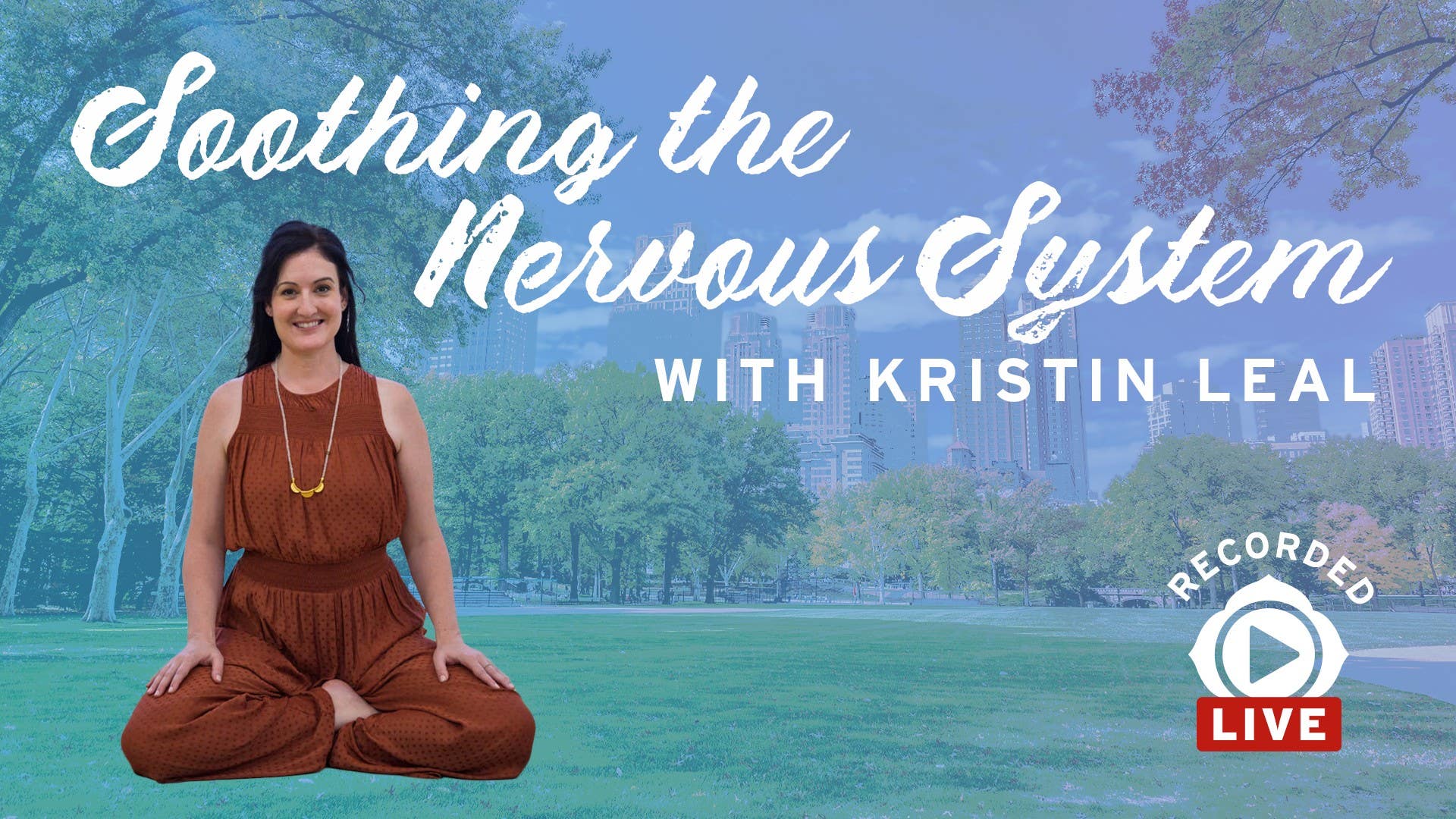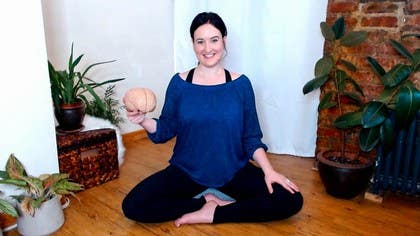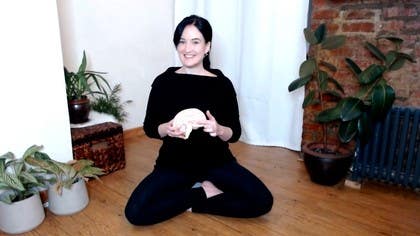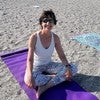Description
Journey to the center of your mind and enjoy a clearer perception and discernment. After seated breathwork, Kristin tells us about brain waves, dispels a meditation myth, and relates the Buddha story of the 10,000 Moons, before moving into our Yoga Nidra practice. You will sense the tranquility of the still mind.
You can follow along with the Grounding Mantras at the end of each class by accessing the PDF attached below.
About This Video
Transcript
Read Full Transcript
Welcome. We are going to start in a seated position, so get comfortable whether you're seated in a chair or on a yoga type prop situation. Just organize yourself so that you can be tall and somewhat comfortable for the next few minutes. And as you're ready, let's turn the palms to face down on the knees or thighs, just in an effort just to arrive fully here. And if you're comfortable closing your eyes, making any final adjustments to your body just so you can start to settle.
As you start to settle in and the body quiets down, I always have this image like you're shaking up a snow globe all day long and you get to put it back down on the shelf. It takes a while to watch everything settle, but as it does, you can just see with a bit more clarity. So as things settle, just start to turn or hone the level of your attention towards your own mind. And as you do that, sometimes there's a very understandable desire to somehow create a more yoga like mind, something more holy, whatever that means to you, and we try to stop the thoughts or create like more yoga type thoughts. Final notion here, instead of doing that for the next minute, just somewhat dispassionately watch the wanderings of the mind without the particular quick need to judge or fix or stop.
Just observe the ripples of the mind as they are in this very transient moment of right now. Thank you. Now, almost like a little laboratory experiment, do a very brief pranayam practice, breathing exercise, just as a little experiment to see what it offers you on the level of the mind. So bring the awareness towards your breathing now and start to draw in more conscious breaths in and out through the nose. Don't worry about creating like your biggest breath possible, in fact maybe only about 50% of your capacity.
Just to give the mind a bit of a task here, just begin to count on the breath, inhaling for four and exhaling for four. So whatever that, however fast or slow that is for you, just inhaling for four counts and exhaling for four counts on your own. No need to strain and quite reasonable breath in and out. Just finding little equanimity, inhale for four, exhale for four. Just going to zhuzh it up a bit, make it a little bit more fancy.
Just inhale for four and then at the top of the inhale just suspend, hold for four counts and then exhale for four counts and then pause at the end of the exhale for four counts. So this is sometimes called a box breath, you're inhaling for four and pause for four counts, then you're exhaling for four and then again pausing for four counts. Again just a reasonable breath, no need to force or gulp, just in for four, hold for four, out for four, hold the exhale out for four. Just a few times on your own, if it's starting to feel unreasonable just move back to in and out for four without the holding. Inhale for four.
Just a few more rounds like that. Just a few more rounds like that. At the end of your next round, complete the round you're on. Just relax the breath, no longer having to shape it or stretch it or count it. Just let it move back into that unfussed with version.
And then just simply observe whatever there is there to observe in the state of the mind. Not trying to get the answer right or fix anything, just dispassionate observation, curious. And then let's bring the chin down to the chest. Take your time. As you're ready, you can flutter your eyes open. Maybe gaze at one point on the floor in front of you, hazy, hazy gaze.
As you're ready, you can allow the rest of the room to come back into your focus. Well done. All right, stretch your legs out, give them a little shake, make any adjustments that you need. We're going to continue on our journey in the nervous system and talk a little bit more about the brain today. And there's a very kind of persistent myth about the brain, and it seems to creep up in movies every few years or so there's a movie release that kind of tries to capitalize on this myth.
But the myth is that we only use 10% of our brain. I'm sure you've heard that before, right? We're only using 10% of our brain, if only. So the brain, it is true, of course, that we have 86 billion or so, give or take a few billion neurons in the brain. And each one of those neurons have little finger-like projections off of them called dendrites that could have about 10,000 of those different finger-like projections that can communicate with another finger-like projection in one of those other 86 billion neurons. So it is true that we can rewire and repattern and these neurons can talk to one another in near infinite amounts or different ways, right? There is a huge potential, what we call neuroplasticity, to rewire the way these neurons can talk to one another.
And at the same time, we're using the entirety of the brain, not just 10%. The brain is a collaborative organ and many different parts of the brain are utilized even in a simple activity like riding your bike or listening to me right now. You're seeing me, you're getting visual input and that's going in one place. You're hearing my voice, that's going in another place. You're seeing me move, you're seeing weird movements of my face and that's making those same little micro-movements in your face so you can kind of connect with me and connect with this conversation, right? And all of this is happening in all different parts of this little three-pound organ of the brain, right? So it's a very collaborative organ and we can measure the amount of activity, electrical activity of how fast these neurons or how slow these neurons are talking to one another by using these different brain waves. I'm sure you've heard of it or seen it in a movie or maybe you've had this done to you where they put these little sticky pads on your skull and it's measuring how fast those neurons are talking to one another.
And those waves are pretty much classified in four categories. There's more than that, but they kind of fall mostly in these four categories. And different parts of the brain can be in different rhythms, right? It's not an all or nothing principle here. So right now, I'm hoping that what's called beta waves are predominant in your brain, in my brain, hopefully, right? This is the more fast talking between the neurons. So you're hearing me, you're forming questions in your head maybe, you're kind of using your own knowledge from your own past and seeing how my information lands with it. All of this is a wake stage where the beta waves, the fast moving electrical activity is predominant in the brain, in the various different areas of the brain.
Then as you start to relax, right, maybe you're sitting a little bit lower in your seat, you're getting a little, maybe even lying down right now and you kind of snuggled up with a blanket, right? Maybe that feeling after Shavasana when you kind of like get up and you walk into the kitchen and you're like, why am I here again? Like that feeling, that's when you're starting to maybe move towards more alpha rhythms, slightly slower than beta waves. So this is the kind of chill out relaxation, maybe what's called hypnagogic state where, you know, if you're, this used to happen to me all the time when I was on airplanes, back in the day when I was on airplanes, where you'd be sitting and kind of like, you know, relaxing, maybe trying even not to fall asleep and your head will go. You can't hold up your head and you lose muscular tone, right? And that's in that kind of alpha rhythm and alpha tends to be a very transitional period. You're not in it for too long.
You either fall asleep or you like stimulate yourself to wake up again. So the slightly slower rhythm of alpha waves predominant or predominant when we're in something like Shavasana, right? Or a relaxation state. Then you maybe fall asleep and you start to have rapid eye movement, the dream state of sleep. And this is when theta waves will be predominant, slightly slower, slightly more relaxed, but still activity. And then you fall into that sweet moment of sleep where it's called deep sleep, non-REM movement, very slow rhythm of electrical activity of how these neurons are talking to one another.
And this is that deep sleep state. Those waves, delta rhythm waves will be predominant in the brain. Now I say predominant because it's not the whole brain that's going into this rhythm. Your brain is almost like an orchestra with different instruments and they're all playing at slightly different times, slightly different volumes of activity. And even when we meditate, I think there's sometimes a myth of when we meditate that we're supposed to have a completely still mind, that there's no activity that we're supposed to kind of quiet or turn off the mind. And I think that holds us back from meditating. I've had many people in my life talk to me about meditation. They say, well, I can't do it.
I sit and I go into meditation and all I'm doing is thinking about my grocery list or thinking that I'm not doing it right and all of that kind of stuff. Your brain is in constant activity. It's trying to keep you alive. It's trying to protect you. It's trying to ruminate. It's trying to figure things out, puzzle things together. There is always activity in the mind, especially in this kind of outer wrinkly part of the brain where you're taking in visual and auditory sensations and information stimulus. You're trying to figure out with this executive branch of your brain what to do with all that information. So the outer portion of the brain, even in meditation, if you're reciting a mantra, if you're following your breath, if you're doing a visual, those parts of the brain, the outer cortex of the brain, actually get more activated.
They actually talk a little faster to one another. Beta waves might even be predominant in certain areas of the brain during meditation. So it's not necessarily that we're trying to turn off the mind or quiet the mind, but rather like a conductor that comes into the orchestra pit, kind of bangs his baton on the music stand, he's going to start calling everyone into order. He's going to start to call everyone into playing in rhythm. He's going to tell certain instruments to quiet down. He's going to take certain instruments and raise their volume. We want the conductor to be discerning and to take all this kind of crazy information and to become more harmonious, to become more melodious, I don't know if that's a word, to become just more in balance, in tune, to play well together. When we look at kind of the inner nugget of the brain, so hopefully your brain doesn't do that. Something's gone terribly wrong if it does that, but on my model here, the center portion of the brain is this very kind of, I call it the chewy nugget, the inner chewy center of the brain.
You've got all of these special little parts of the brain on the inside. In science language, they might call it the diencephalon, this inner nugget of the brain, but we've got this middle of the brain, which is very discerning. We have in the very center of the brain what's called the thalamus, and it's almost like two little hen's eggs nestled together in the very center of the brain. And this area of the brain takes in all of the information from the senses first, and it becomes very discerning about what it's going to pay attention to, and kind of send it to the area of the outer cortex of the brain that's going to try to figure it out. And what it's going to gait, what it's going to say, like, not so important right now. We can't focus on everything quite now. So right now, you probably don't feel the close on your skin, until I said that line, and now you're feeling the close on your skin. Right? Because you were always taking in that information, but the very discerning thalamus says, it's not really necessary for your survival, unless you had like an itchy tag or something that was too tight and pinching you. Then it's continuously causing, you know, like pay attention, pay attention, fix me.
Right? But other than that, it's going to say, not so important. We're going to turn the volume down on you. We're going to turn the volume up over here. Right? So it's going to be this kind of very discerning, center chuilangyat of the brain. And then a lot of the meditation practices, at least from my teachers in the tantra or even the Kriya tradition, they use the very center point of the brain as a place to draw attention, awareness, and to find that discernment. Right? Of what to pay attention to, and what you can choose to quiet or turn up. So in the meditation today, we're going to do something in the yoga nidra practice today. We're going to do a practice that really draws our attention to this middle of the brain. And it's what one of my teachers, Rod Stryker, calls the still lake of the mind, to notice the ripples of the mind. And instead of trying to squash them, right, you're just going to draw more ripples, more bubbles to the surface.
We're going to just watch things rise, like little bubbles from the river or from the lake bed, and then just kind of pop at the surface. Right? The ripples will begin to calm and smooth out. And there's this really kind of, I think it's a kind of funny story about the Buddha, kind of a story about the Buddha sitting with his students. And one of his students asked him, hey Buddha, how is your mind different than our minds? And the Buddha, who doesn't mess around, the Buddha says, your mind, 10,000 moons, my mind, one moon, which is kind of like, it's kind of a dig. But what I think it means, what I think he meant was, if you're looking at a still lake bed, right, and you see the moon reflecting, you're going to just see the image of one moon reflected on that still lake. If there's a lot of ripples in the lake, if there's a lot of ritti, if there's a lot of activity, that reflection of the moon is going to be 10,000 moons.
It's going to be quite, you're going to perceive something that's not actually there. Right? Your perception gets clouded. Right? So Buddha says, my mind, one moon, your mind, 10,000 moons. Buddha don't play. Right? All right. So in the still lake of the mind practice that we're going to do, we're going to observe the ripples and perhaps allow them to quiet using different techniques to enjoy clearer perception, more discernment. That's the plan, at least. So let's get started. You can come down onto your backs and set up for your yoga nidra practice.
I'm going to put my brain away. And set up well. So because we will be here for maybe about 30 minutes or so, you want to make sure that you're both comfortable and warm. So something that maybe looks like shavasana, where you're resting on your back. If that's not an option for you or your body, you can rest on your side, maybe snuggled, spooning a big pillow. You can do this in a chair if you'd rather or need be. Totally cool. If you're on your back, maybe take a pillow underneath your knees just to give your low back some comfort.
And then if your room is a little bit chilly, you can take a blanket on top of you for a warm. If your room is pretty bright, you might enjoy like a scarf or a light eye mask or something over the eyes. Get nestled in. And then close your eyes. Use these last few moments to take anything that you need.
Even if you think you can tough it out, please make yourself comfortable. So you can limit the distractions. There'll always be some. But you can start to quiet the body. You can draw your heels a little wider than your hips. Turn your legs in and out a few times.
Moving your arms a little bit away from the sides of the body, turning the palms to face up. Turning your head a little side to side. Do you find a really sweet position for your head and neck? And then let's draw the awareness to the muscles of the face. And just begin to squeeze and tense all of the muscles of the face.
So squeeze the eyes closed, wrinkle the forehead, squish up the nose. You can even clamp the jaw, purse the lips. Squeeze and tense all of the muscles of the face and jaw. Even into the neck, scalp, all the muscles of the face, tight, tight, tight, tight, tight. And now release the muscles of the face, smoothing the brow.
The eyes and eyelids soften. The scalp softens. The jaw unhinge slightly, the lips part ever so slightly. The tongue falling into the floor of the mouth behind the lower set of teeth. All of the muscles of the face, neck, relax.
Bring your awareness down to the right arm. Curl the right fingers in towards the palm making a fist with your right hand. Squeeze the fist and feel that tightening of the muscles rise up through the right forearm, elbow, upper arm, into the right shoulder. All of the muscles of the right arm hugging to the bone, tight, tight, tight. And now release the muscles of the right arm, the entire right arm soft, right arm heavy, whole right arm heavy.
Bring your awareness to the right leg, squeeze the right toes into a little toe fist. Feel the right arch, ankle, calf tighten. The right shin, the knee, the thigh, even the right hip and the right seat. All of the muscles of the right leg hugging to the bone, tight, tight, tight. All of the muscles of the right leg engaged, hold.
And then release the muscles of the right leg and foot. The entire right leg releases soft, whole right leg heavy. The left arm. Curl the left fingers into the palm squeezing your hand into a fist. Feel that contraction rise up through the left forearm, elbow, upper arm, into the left shoulder.
Squeeze and tighten all of the muscles of the hand and arm. Squeeze and hold tight, all of the muscles of the left arm tight, tight. And then release the muscles of the left arm and hand, the entire arm soft now. The whole left arm heavy. The left leg, curl the left toes into a little toe fist.
Feel that contraction rise up through the left arch and ankle and calf, shin. It rises up through the left thigh, hip, seat. All of the muscles of the left leg tighten, squeezing. The whole left leg active. And release, release all of the muscles of the left leg, foot, entire left leg heavy, soft.
Slide the awareness to your belly. Squeeze the belly in towards the spine, squeeze, contracting all of the muscles of the abdomen, even a sense of the organs themselves squeezing towards the spine. Squeeze and hold all of the muscles of the belly tight, tight, tight, tight. Now release, release all of the muscles of the belly, the whole belly soft. Relax the entire abdomen, sense even of the organs falling back towards the spine.
The whole belly soft. Feel the chest spacious, clear. The neck and throat easy. The whole body now at rest. Feel the whole body at rest.
Notice as you relax a little deeper, the breath grows quiet and be even hardly noticeable. Just rest your mind on any sensation of the breath, any movement of the breath that you might experience in the belly. Be aware of the very easy movement of the breath that remains in the belly. Feel the awareness of any experience of the breath, its perfect subtle state in the chest. Just any awareness of the ripples of breath in the chest.
Now any experience of the movement of breath in the nostril. Tiny rise and fall through the walls of the nostrils. Like two streams that merge back to a point in the middle of the brain. Keeping the breath relaxed completely at peace, just notice as you happen to inhale it rises through the left nostril. As you happen to exhale it moves down and out through the right nostril.
As you happen to inhale it moves up the right nostril. As you exhale down through the left nostril, just mental alternate nostril breath. No need to try, just note, inhaling through the left, out through the right, in through the right, out through the left. No need to try, just note, inhaling through the right nostril breath. No need to try, just note.
No need to try, just note. No need to try, just note. Release the technique. As these two independent streams merge back towards their source. Bring the awareness into the very middle of the brain.
You might experience just the seed of your awareness, density of your presence, might see your experience of glow. You might see or feel or sense in the middle of the brain the still lake of the mind. Just see or feel or sense the still lake of the mind. If thoughts come to see them as ripples that begin to dissipate, the water growing calm, tranquil. No need to try, just note.
No need to try, just note. Feel or sense at the back of the head, bright luminous full moon, the glow of the full moon, the back of the head, the moon beams shining down onto the surface of the still lake. The shining light of those moon beams shines down onto the lake. The light begins to reflect off the lake out through the third eye, the space in between the eyebrows. The light projects the image of a five-pointed star.
You might see or feel or sense the full moon, the back of the head, cooling moon beams shining down on the still lake of the mind. And the light refracting out, reflecting out through the third eye into a five-pointed star. You might see or feel or sense the full moon beams shining down onto the surface of the sky. You might see or feel or sense the full moon beams shining down onto the sky. You might see or feel or sense the full moon beams shining down onto the sky.
Bring your awareness back to your body. Without opening the eyes, just clearly see yourself resting here, the room that you're in. Begin to deepen the breath. Slide your tongue across your teeth, the thumb over each finger. And then take your tongue and press it to the roof of your mouth, where the hard palate turns into the softer part of the palate, what my tradition calls Lalana Chakra.
Just give it a little press just to help root you back here. And take your hands and just begin to place your hands over your closed eyes, just feeling a sense of that heat or energy, the remembrance of that practice, begin to move down through your body. So you're allowing any portion of the practice that was resonant for you stay with you. Feel the heat wash through the back of the eyes, face, sense of it through the brain. I'm going to sing the grounding mantras. You can just listen and feel. Sliding the hands down the sides of your face and jaw into the back of your neck, from the back of the neck, taking one hand lightly over the other hand over the throat, just feeling it permeate, throat, speech, all of the muscles of articulation.
Om Mayim Saraswatiye Namaha. And slide your hands down over the heart center, center of your chest. So anything that you're looking to carry with you from that practice, move into the heart. Om Namo Narayanaya, Om Namo Narayanaya, Om Namo Narayanaya, Taking your feet onto the pillow or floor. You can pick up your knees and maybe hug them towards your chest, squishing your belly.
And as the awareness starts to land, practice starts to be planted in that naval center. You can roll over to one side, whatever side is more convenient for you into a fetal position. You can make a little pillow with your head, with your arm. And as you roll over in that fetal position, just feel the warmth of where the floor was underneath you, particularly down into the sacrum. Um Lakshmi Vamshri Kamalara Ramsvaha.
Keeping your eyes closed and your head heavy, you can use your hands to help drag you lazily back up into any seated position that works. And in your seated position, you can take your hands to the crease line between your hip and thigh and just give a good press down. You can draw your elbows back, nudge your spine up a bit taller, lift the heart inside your chest and bring your chin down. And just feeling the practice root down into the very roots of your spine, your legs. And release your arms and bring your hands together in front of the heart, head bowing to the heart. Taking the practice and rooting it deep so it can grow into each moment of your living.
Bowing to your true teacher, your inner teacher and sanskrit umbaloshri satguru bhagavan ki. Jai. Namaste.
Soothing the Nervous System
Comments
You need to be a subscriber to post a comment.
Please Log In or Create an Account to start your free trial.













